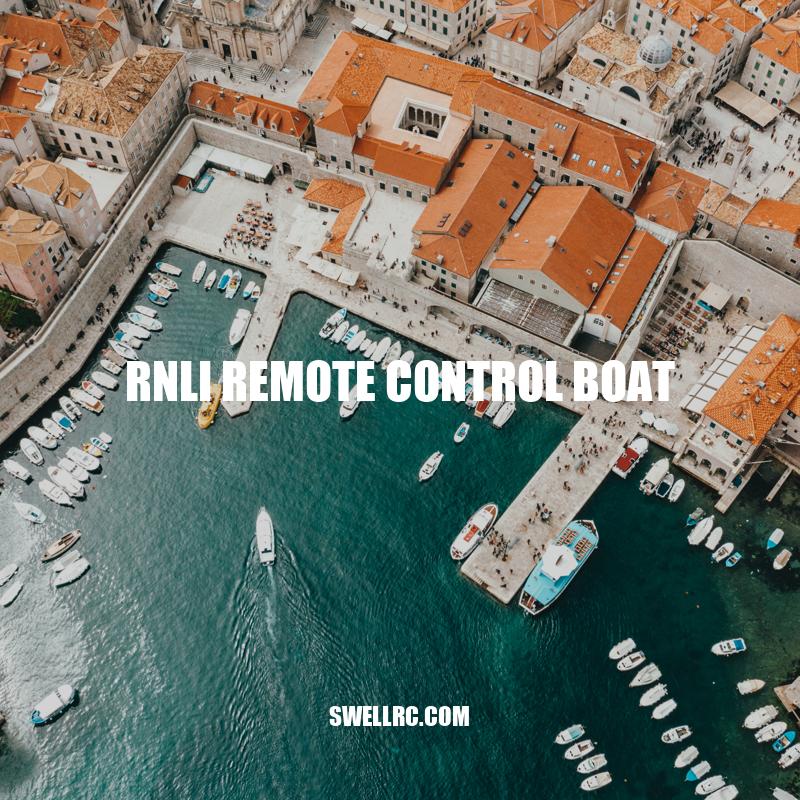RNLI Remote Control Boat: A Cutting-Edge Tool for Daring Sea Rescue Missions
The Royal National Lifeboat Institution (RNLI) has been saving lives at sea for almost 200 years. Over this time, the organization has become a standard-bearer for maritime safety and has tirelessly worked to develop new technologies and approaches to assist its mission. One such technology is the RNLI remote control boat, which is among the latest and most cutting-edge tools in the organization’s rescue arsenal. These boats are specially designed for use in situations where it may be dangerous for a human crew to approach, such as during a dangerous storm or in hazardous water conditions. In this article, we will delve into the features and specifications of the RNLI remote control boat, the training and operation of the boat, and the organization’s future plans for remote control boats. Additionally, we will examine how these boats are being used in rescue missions, highlighting their importance as part of the RNLI’s lifesaving efforts.
Features and Specifications of the RNLI Remote Control Boat
The RNLI remote control boat packs a number of features and specifications that make it a suitable and effective tool for sea rescue missions. These include:
- Size and weight: The boat is compact and lightweight, which makes it easy to transport and maneuver around in tight spaces.
- Speed and range: The boat can travel at high speeds of up to 25 knots and cover a considerable distance of up to 1.6 nautical miles from its control station.
- Power and control: The boat is powered by a rechargeable battery that provides up to 1 hour of continuous operation. It is controlled by a remote and is fitted with video cameras and sonar technology.
- Design: The boat’s unique design enables it to remain stable and maneuverable in rough seas while still maintaining maximum speed.
These features and specifications make the RNLI remote control boat an excellent tool for the RNLI rescue teams.
How does a remote control boat work?
A remote control boat works by using radio signals transmitted from a controller to a receiver on the boat. These radio signals are translated into electrical instructions that control the boat’s speed, direction, and steering.
Here are some key components of a typical remote control boat:
- Transmitter: This is the controller that sends radio signals to the boat.
- Receiver: This is a small device on the boat that receives the radio signals and translates them into electrical instructions.
- Battery: Most remote control boats are powered by rechargeable batteries.
- Motor: The motor is responsible for driving the boat forward and turning it left or right.
- Propeller: The propeller is attached to the motor and helps to propel the boat through the water.
If you’re interested in purchasing a remote control boat, there are many websites and products available. Be sure to do your research and read reviews before making a purchase.
Use of the RNLI remote control boat in Rescue Missions
The RNLI remote control boat is primarily used in situations where it may be dangerous or impossible for a crew to approach. Some of the ways the boat is used in sea rescue missions include:
- Search and rescue operations: The boat can be launched from the shore or a larger lifeboat to search for missing persons, survivors or wreckage in hard-to-reach areas.
- Surveying and surveillance: The boat is equipped with video cameras and sonar that enable it to map and survey the sea floor and locate objects of interest from a safe distance.
- Assisting casualty vessels: The boat can be used to provide assistance or deliver equipment to boats that have suffered technical difficulties or are stranded.
In a 2021 incident near Scotland, the RNLI remote control boat was used to locate a man who had fallen from his boat and was in the water. Thanks to the boat’s quick response and advanced technology, the man was located and rescued within minutes of the incident.
Table:
| Benefit | Details |
|---|---|
| Safe operation | The remote control boat can be operated from a safe distance, reducing the risk to human life. |
| Increased efficiency | The boat can cover large areas of water and locate casualties faster than human crews can. |
| Cost-effective | The remote control boat is cheaper to operate than a manned lifeboat and requires fewer crew members. |
What is a remote control boat?
A remote control boat, also known as an RC boat, is a miniature boat that can be controlled wirelessly through a remote control. It is usually equipped with a motor that powers the boat and allows it to move on water.
Here are some key facts about remote control boats:
- RC boats come in various sizes, from tiny models that fit in the palm of your hand to larger ones that can reach speeds of up to 60 mph.
- They can be powered by gas, nitro, or electric motors.
- RC boats are popular among hobbyists and enthusiasts who enjoy racing or performing stunts like jumps and flips on water.
If you’re interested in purchasing an RC boat, there are many websites and products available that cater to different preferences and skill levels. Some popular brands include Traxxas, Pro Boat, and AquaCraft.
Training and Operation of the RNLI Remote Control Boat
Operating the RNLI remote control boat requires specialized training and expertise. Here are some of the key aspects of operating the boat:
- Specialized training: Operators of the boat undergo specialized training on safe operation, navigation, and use of the boat’s technology.
- Qualifications required: Only trained and qualified RNLI crew members are allowed to operate the boat during rescue missions.
- Maintenance: The boat is maintained and serviced regularly to ensure it operates at peak performance.
During training, operators learn how to use the boat’s advanced technology, such as its video cameras and sonar, to locate missing persons or objects in the water. They also learn to navigate the boat safely in difficult sea conditions.
The RNLI also invests in research and development to improve the technology and operation of their remote control boats. For example, in 2020, the organization invested in drone technology to help locate persons in distress, particularly in areas with difficult terrain or weather conditions.
If you are interested in supporting the RNLI in their mission to protect lives at sea, you can visit their website at www.rnli.org. The website provides information on how to donate, volunteer, or contribute to their rescue efforts.
How does the RNLI operate?
The RNLI (Royal National Lifeboat Institution) is a charity that provides 24/7 lifeboat search and rescue service in the UK and Ireland. Here are some key facts about how the RNLI operates:
- The RNLI is made up of over 235 stations around the UK and Ireland, staffed by 4,700 volunteer crew members and 1,500 volunteer shore crew.
- The RNLI operates over 350 lifeboats, including all-weather lifeboats, inshore lifeboats, and hovercrafts.
- The RNLI is funded entirely by charitable donations, with no government funding. They receive no funding from the National Lottery either.
- The RNLI provides safety education and training to the public, including water safety advice and first aid training.
- The RNLI website provides information about how to stay safe on the coast, as well as how to support their work through donations or volunteering.
The RNLI is continuously investing in innovative technology and techniques to improve their life-saving efforts. Here are some potential future developments for the RNLI remote control boats:
- Improved speed and range: Future remote control boats may be designed with increased speed and range, allowing them to reach more areas in need of assistance.
- Advanced technology: The RNLI may continue to invest in advanced technology for their remote control boats, such as artificial intelligence or machine learning, to improve their rescue capabilities.
- Collaboration with other organizations: The RNLI may partner with other organizations and companies to develop new technology and innovations for remote control boats in the future.
As technology continues to evolve, remote control boats may become an increasingly important part of the RNLI’s rescue efforts. By investing in research and development, the organization can ensure that their remote control boats continue to be effective tools for saving lives at sea.
If you are interested in staying up to date on the latest news and developments from the RNLI, you can visit their website at www.rnli.org. The website provides information on their current rescue efforts and initiatives, as well as updates on any new technology or techniques they are using to save lives at sea.
How many life boats are operated by the RNLI?
The Royal National Lifeboat Institution (RNLI) operates 238 lifeboat stations across the UK and Ireland. At these stations, they have a total of 441 lifeboats. These lifeboats vary in size and type, and are designed to fit the specific needs of each station and the surrounding waters. Some of the types of lifeboats the RNLI operates include:
- All-weather lifeboats
- Inshore lifeboats
- Atlantic 85
- D-class lifeboats
- Rescue watercraft
For more information about the RNLI and their lifeboats, you can visit their website at www.rnli.org.
Conclusion
The RNLI remote control boat is an example of innovative technology being used in life-saving efforts. The remote control boat has proven to be an effective tool for reaching areas that may be difficult for larger lifeboats to access and for finding and retrieving survivors in dangerous seas.
As technology continues to evolve, the RNLI may continue to invest in advanced technology for their remote control boats. Some potential future developments include increased speed and range, advanced technology such as artificial intelligence, and collaboration with other organizations.
Overall, the RNLI remote control boat has demonstrated that technology can be a valuable asset in life-saving missions. As the organization continues to improve and expand their capabilities, they will be better equipped to handle any emergency situation that arises at sea. By supporting the RNLI through volunteering, donations, or spreading awareness, individuals can play a part in helping to save lives at sea.



